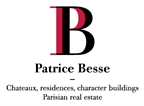In the south of Calvados, 2 km from the centre of Vire, a 17th and 18th century mansion on the banks of a river - ref 342903
In the south of Calvados, 2 km from the centre of Vire, a 17th and 18th century mansion on the banks of a river.
In undulating pasturelands, the property is located near Vire, at the confluence of two rivers, topped by rocky cliffs and coppiced woods. The train station is 5 minutes away and connects to Paris in 2h40. The beaches of the Côte de Nacre or Utah Beach can be reached by car in just over an hour. Caen and the beaches of Granville are a 50-minute drive away.
From a side road leading to Vire, a drive leads down to the mansion. It runs along the millstream lined with tall trees, then continues past the old mill, part of which has been converted into a large garage. The mansion and its lawns are surrounded by gravel paths. It lies at right angles to the reach that separates the building from the grounds comprising a large grove and vast stretches of lawn. A very high rubble masonry wall runs partly along the river, creating a separation from one side of the park.
The mansionIt comprises two buildings standing in the same line. The first dates back to the 17th century. It is on two levels with some attic space. The second 18th century building is higher and offers three levels, including the attic. The roofs are slate. The first one has two pitches with hip dormers. The second is a Mansard roof and features a large chimney stack and high dormers, topped by triangular pediments. The walls are coursed schist masonry, and the window frames and corner quoins are dressed granite blocks. The facades are divided into three bays. The entrance door is at the intersection of the two buildings.
The ground floor
An entrance area precedes a full-width hallway with the start of a wooden staircase and toilets. The hallway leads to a living room in the newer part and a dining room in the older part. The extensive living room enjoys a considerable ceiling height. It is lit on two sides by high windows. The walls are half-panelled, the ceiling is adorned with cornices, and the floor is straight parquet. The marble fireplace is surrounded by two windows. A double glass door opens onto the terrace and the garden beyond. Another door leads to a long room, also lit by high windows, which has been converted into a library on one side and a laundry room on the other. A glass door opens to the outdoors, where a balcony overlooks the stream that runs under the house. The dining room has a more intimate character. It is also illuminated by a glass door opening out to the rear of the house. A wooden staircase leads to the first floor. The connecting kitchen stretches over the entire width of the house. The old dressed granite fireplace has been preserved and integrated into the new interior design. A door leads to the outbuilding set at right angles to the rear of the house where the boiler room is located.
The first floor
Two staircases join the first level of each building. A connecting door at mid-level communicates between the two buildings. The first floor of the 17th century building can be turned into a self-contained flat with three rooms, including a shower room and a space that could be converted into a kitchen. Part of this level has sloping ceilings. From the small landing, a staircase, hidden behind a door, leads up to the convertible attic. A separate entrance is accessed from the courtyard via an external stone staircase. The first floor of the 18th century building comprises a large bedroom and bathroom with toilet, as well as a large boudoir and a closet. All the rooms feature high windows letting the light pour in, protected by small wrought iron railings.
The second floor
The staircase leads to a long corridor serving all the rooms, including a shower room with toilet and three bedrooms. Marble fireplaces have been preserved in one corner of each bedroom. They are lit by ...


